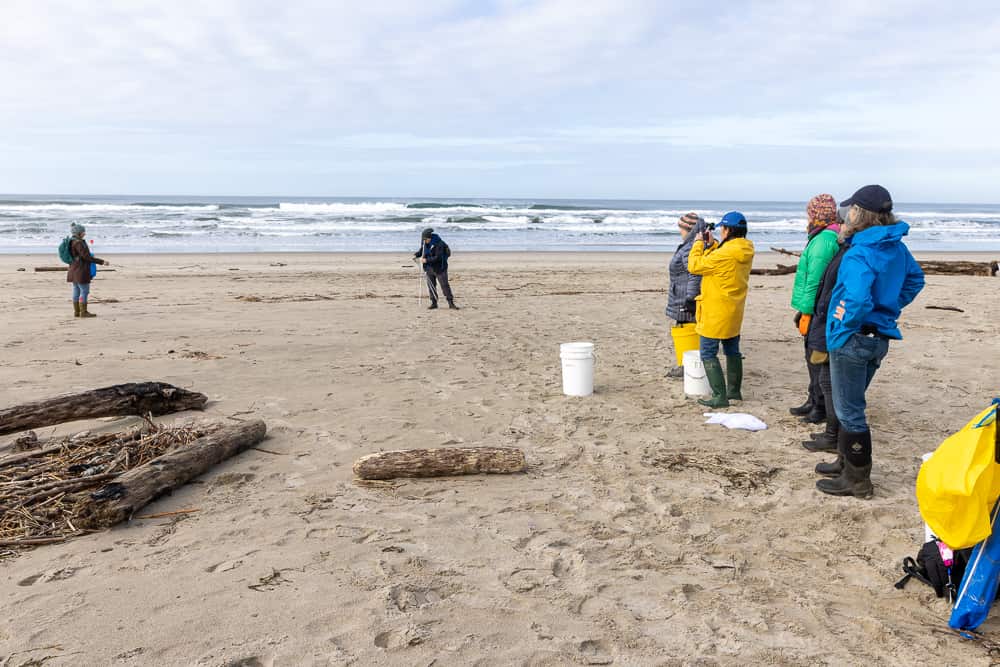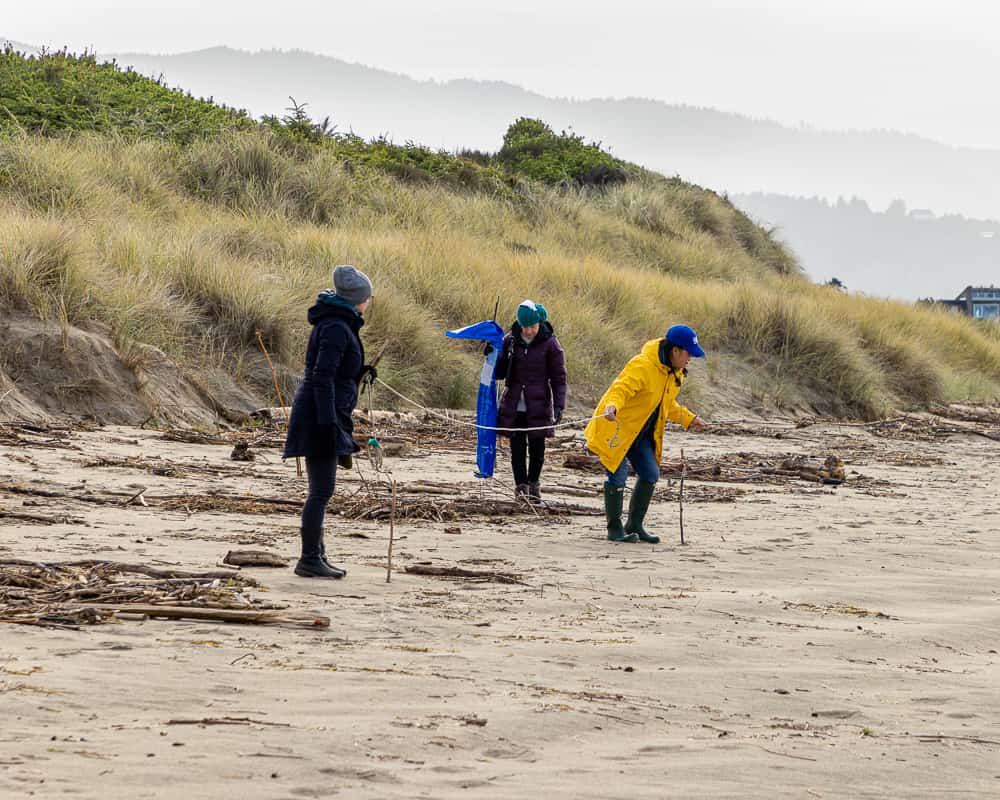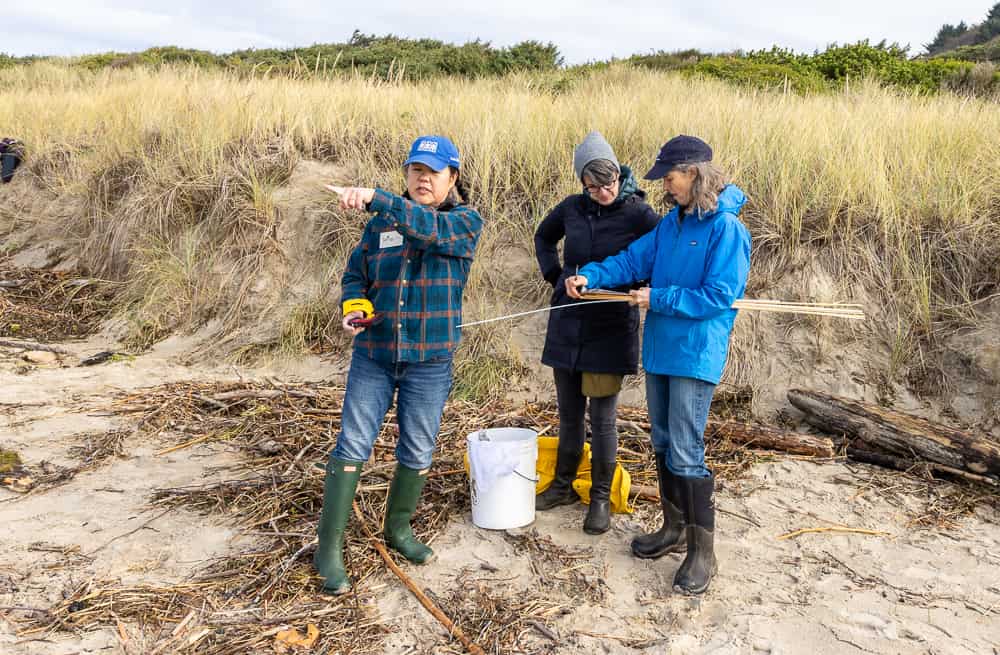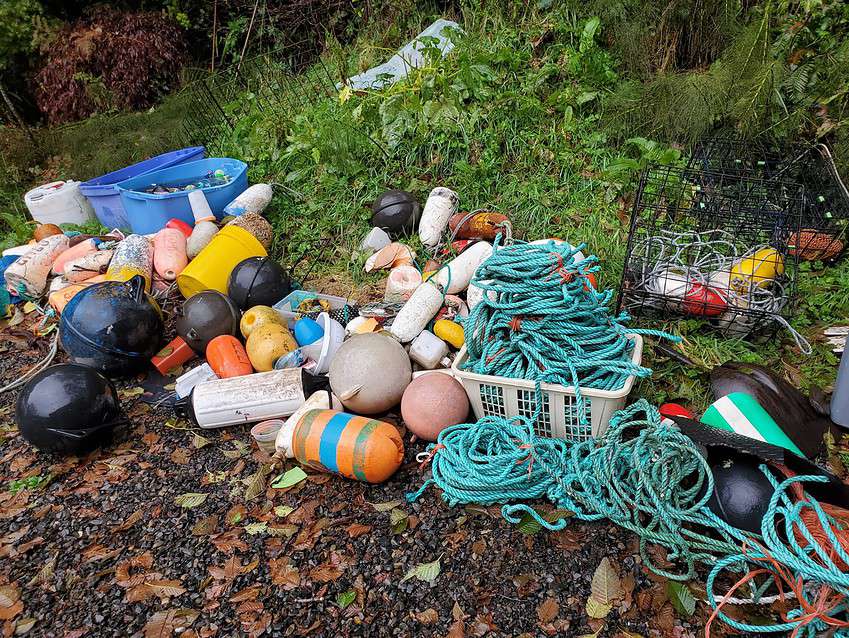By Don Backman
“We need to lay out four transects in 100 meters of beach,” Denise Harrington told the group gathered around the edge of the bank at the edge of Manhattan Beach. She pushed a marker flag into the sand and started measuring out a grid. Around her, the group participants watched as she explained how to set up a marine debris grid. This was the marine debris survey and collection portion of the Trash Art event put on by the Heart of CARTM. Using sections of rope she then measured out five meters and pushed another stake into the ground. Then, groups divided up into teams of two and began laying out their own grids.
“Fifty-one yards,” the first group called back after using sticks to mark out a 5 meter wide corridor from the short vertical bank at the edge of the dune down to the water. It was fifty-one yards to the water. They then set to examining their transect for marine debris.
“They are looking for any man-made debris here intentionally or unintentionally,” Harrington explained. “They will collect any debris, but will record items the size of a bottle cap or larger. Roughly one inch square. The idea is to find out what is here, then enter that into a NOAA (National Oceanic and Atmospheric Administration) database.”
Denise Harrington, who retired from Tillamook School District last year after 15 years in the district, immediately went to work as a NOAA Teacher at Sea Fellow (TASAA fellowship) for the National Marine Sanctuary Foundation. “I literally finished one week and started with NOAA the next,” she said.
Harrington had taken a circuitous route to education. “I was a wilderness ranger in the John Muir wilderness,” she explained. “I liked hiking (backpacking) the high ridges away from the trails. It was a great job.” After finishing college, she became an attorney for 15 years. “I eventually wanted to live in an area with water and trees,” she said, and found a place in Garibaldi, Oregon, where there is plenty of water and trees.
NOAA has many opportunities for educators. “While a teacher, I applied for and then went on a cruise mapping the ocean floor off of Alaska. I also went on an expedition in the Gulf of Mexico. Both times I was working with scientists on real science.” Harrington pointed out that NOAA has many opportunities for young people. “NOAA is a uniformed service. It is a lot like an apprenticeship. They train you for a variety of jobs within the service.”
“Twenty-five percent of the time I get to work on my own projects.” Marine Debris is one area she mentioned, and another is helping audiences that don’t normally use NOAA resources. “They (NOAA) want all teachers, not just science teachers, to get involved. Oceanography applies to all levels, pre-school to college level.”
(Another) “Twenty-five percent of my job involves working for the NOAA Alumni Association. The only requirement is I have to do public blog posting.” This gives her flexibility in following her interests. She described leading a book club via zoom with members from California and Arizona.
“Fifty-percent of my job is working on different NOAA projects around the US. This involves working on the NOAA marine debris program and marine debris surveys and creating an educators guide for 6 – 12th grade.”



Back on the beach, each group had constructed rows of stakes running down to the waterline. For this event, Harrington partnered with Heart of CARTM out of Wheeler. Under the direction of Executive Director Jessi Just, the organization put on the Transforming Marine Debris: A Creative Retreat with Art & Writing event.. Heart of CARTM explains on their website: “As Heart of CARTM, our work prioritizes reuse, repair and creative expression. We see our work – leading the community to zero waste – over the last 25+ years as a huge success, moving the focus away from landfill, first with recycling, then with reuse and now with repair and upcycling. We will continue to re-imagine our community’s waste as valuable resources.”
“The Transforming Marine Debris Creative Retreat is designed to bring people who care about our coastlines together for a weekend of wonder, exploration, and collaboration,” the information on the website reads. “Join us as we delve into the science of marine debris, complete a NOAA Marine Debris Monitoring Assessment shoreline survey, explore ocean trash as a creative prompt, use found object art as a transformative experience, and create a call to action.”
The purpose of marine surveys is to use citizen science, data collected by everyday citizens, to help measure the marine debris problem. NOAA has information available on the Marine Debris web-page to help interested individuals and groups get involved. “The Marine Debris Monitoring and Assessment Project, or MDMAP, engages NOAA partners and volunteers around the world to survey and record the amount and types of marine debris on shorelines. How big is the marine debris problem, and how is it changing over time? What types of debris are most common in your region? MDMAP survey data can help to answer these questions and can be used to guide marine debris policy development, provide education and outreach, and address important research questions.” This information can be found at https://marinedebris.noaa.gov/monitoring-toolbox.

